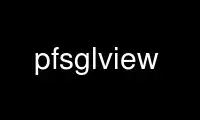
This is the command pfsglview that can be run in the OnWorks free hosting provider using one of our multiple free online workstations such as Ubuntu Online, Fedora Online, Windows online emulator or MAC OS online emulator
PROGRAM:
NAME
pfsglview - Viewer for high-dynamic range images in pfs format
SYNOPSIS
pfsglview [--h] [--v]
DESCRIPTION
pfsview is a OpenGL/GLUT application for viewing high-dynamic range images. It expects pfs
stream on the standard input and displays the frames in that stream one by one.
DYNAMIC RANGE WINDOW
To show high-dynamic range data on a low-dynamic range monitor, pfsglview uses concept of
a dynamic range window. The dynamic range window is the highest and lowest value that
should be mapped to black and white pixel. Values above or below the window are clipped
(see clipping methods below). The dynamic range window is displayed in pfsglview as a blue
area on the dynamic range scale (second toolbox from the top). The window can be moved,
shrunk and expended using a mouse or a keyboard.
ZOOMING AND PANNING
To zoom image, the mouse can be dragged in vertical direction with the left button
pressed. Pressing [space] button or pressing left mouse button above the statistic window
(left-bottom corner) changes from zooming to panning modes and vice versa. To pan image,
the mouse can be dragged in vertical and horizontal directions with the left button
pressed.
POPUP MENU OPTIONS
Zoom reset
Set default zoom parameters.
Zoom in
Increase image (mouse dragging with left button pressed).
Zoom out
Decrease image (mouse dragging with left button pressed).
Increase exposure
Move dynamic range window into higher luminance values.
Decrease exposure
Move dynamic range window into lover luminance values.
Extend dynamic range
Extend dynamic range window.
Shrink dynamic range
Shrink dynamic range window
Low dynamic range
Set dynamic range window to <-1,1> range (log scale).
Fit to dynamic range
Set dynamic range windo to minimum and maximum luminance of a given image.
Choose channel
Change image data channel.
Mapping method
Change mapping method (see below for details).
Next frame
Display next image from the pipe.
Previous frame
Display previous image from the pipe.
Histogram
Switch on/off histogram window.
Info Switch on/off info window.
Save&Quit
Send the visible LDR image (8-bits) to stdout and quit pfsglview.
MAPPING METHODS
High-dynamic range data are usually better visualized using non-linear scale, for example
a logarithmic or a power function. pfsglview offers several such scales, shown in popup
menu. Gray-scale values for each mapping method are computed by the formulas:
LINEAR: y = (x-min)/(max-min)
GAMMA: y = [ (x-min)/(max-min) ]^gamma
LOGARITHMIC: y = (log10(x)-log10(min))/(log10(max)-log10(min))
where y is the gray-scale value after mapping, x is an input HDR value, min and max are
lower and upper bounds of the dynamic range window.
EXAMPLES
pfsin memorial.hdr | pfsglview
See the memorial image.
pfsin memorial.hdr | pfsglview | pfsout memorial.jpg
See the memorial image and save the clipped (8-bits) version to memorial.jpg
(Save&Quit option from popup menu should be activated).
Use pfsglview online using onworks.net services
